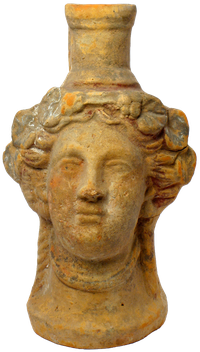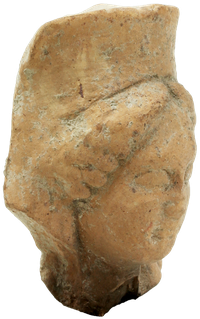Vessel with woman's head
|
|
Vessel with woman's head, Inv. T III-1 Provenance: Unknown; bought at auction in 1908 by Bruno Sauer from the Vogell Collection in Kassel. State of preservation: Complete except for minor injuries at the spout and at the base of the handle on the right. Bruises on the handle itself, on the tip of the nose, the cheeks and on the right side of the forehead. Transverse tear through the wreath on the left side extending into the back of the head. Composed of two roughly equal parts; front and back from the mould, the latter not worked out, smoothed. The mouth of the vessel open at the top. Bottom closed, flat, with handwritten notes in Cyrillic script. Light red (5YR 6/7) clay. Remains of engobe in the hair and on the wreath, especially on the right, as well as on the neck and left cheek. Abundant traces of paint: blue on the wreath, on the neck ornament, on the leaves and on the right eye; dark red-purple in the hair and on the back of the head, especially on the left side. Dimensions: H: 15,6 cm; W: 9,2 cm; D: 9,3 cm. References: J. Boehlau, Griechische Altertümer südrussischen Fundorts aus dem Besitze des Herrn A. Vogell, Karlsruhe (Cassel 1908) 54 no. 532 pl. 8, 2;A. Klöckner – M. Recke (eds.), Gönner, Geber und Gelehrte. Die Gießener Antikensammlung und ihre Förderer (Gießen 2007) 27 fig. 25; M. Recke, Die Klassische Archäologie in Gießen. 100 Jahre Antikensammlung (Gießen 2000) 38 and note 129. |
Description: It is a jug in the form of a female head and neck, with a foot and high spout. A vertical handle consisting of two clay beads connects the back of the head with the mouth of the vessel below the ribbon-like widened lip of the vessel. The spout has the shape of a cylinder with a profiled rim at the top and bottom.
The head is slightly raised. The oval face with long, smooth cheeks ends in an accentuated chin. The bridge of the nose merges almost straight into the receding forehead. The eyes are set wide apart under arched brows and high orbitals. The upper lids are sharply contoured and overlap the lower lids, which blend softly into the cheek area. Full lips, of which the upper lip is a little wider than the lower, form a closed mouth.
In the hair is a wreath of ivy leaves and berries, held together above the forehead by a narrow band. Divided strands of hair swing loosely to the side; they increase a little in volume above the ears. Rounded curls stand out from the lowest strands. From there, thin, diagonally grooved beads run vertically downwards. They nestle close to the neck, which is adorned with a sculpted hoop.
Commentary: The hairstyle and neck jewellery prove the femininity of the head. The rounded formations next to the cheeks could represent ear ornaments, the vertical bulges their pendants. It is more likely, however, that the latter are corkscrew curls[1]. This is supported by the comparison with a parallel from Kerch, where the curls end as thin twisted strands[2]. The strict vertical strands of curls form a peculiar contrast to the loose duct of the forehead and temple hair, a hairstyle that appears at the end of the 5th century BC and spreads into the Hellenistic period[3]. The motif is found on Western Greek, especially Sicilian[4] shoulder busts, but is also encountered on Greek figural vases of the 4th century BC[5], an Attic creation that was imitated in other workshops. Figural pottery enjoyed great popularity in the Greek-populated areas on the northern edge of the Black Sea[6].
In 1913, the Imperial Archaeological Commission Berlin had acquired the above-mentioned parallel specimen in Kerch[7], with which the Giessen woman's head vessel corresponds, apart from the two decorative elements of chain and ivy wreath, as well as a slight deviation in the hairstyle. As the sales catalogue written by J. Böhlau and Pharmakowsky's reports on the finds from southern Russia, which span many years, show, the northern Black Sea coast in particular was a focal point for sales and presumably also for the production of vessels in the form of human as well as animal heads[8]. It can be assumed that the Giessen head vessel, if not from Pantikapaion (Kerch) itself, also originates from the northern Black Sea region. The handwritten notes on the underside of the jug seem to indicate the word Gerson. It is possible that this refers to the town of Xerson[9] situated at the delta of the Dnieper estuary, a port that could have served as a collection site for the shipment of pottery; however, such considerations are speculative.
The ivy wreath and also the vase type, a wine jug, allude to the area of Dionysus. Since the exact provenance of the Giessen vessel is unknown, it is impossible to say whether it was used in the cult of Dionysus or other gods, in the context of domestic cults or in funerary rites[10]. The figural vases that have been found on the northern coast of the Black Sea come for the most part from funerary contexts[11].
Stylistically, too, the two women's head vessels Giessen T III-1 and Kerch[12] are comparable to heads of figural pottery, starting with the contour line of the faces and the cut of the eyes to the smooth elongated cheek area and the full closed mouth[13]. There are similarities with other heads and busts from sites on the Black Sea, for example from Amisos[14], as well as a female head matrix from Ilion[15].
[1] Cf. shoulder busts from Sicily, M. F. Kilmer, The shoulder bust in Sicily and South and Central Italy: a catalogue and materials for dating (Göteborg 1977) 101-104. 107 figs. 58. 62. 71. The transitions between strands and jewellery are sometimes fluid, as shown by the marking of the earlobes by applied flowers on the twisted curls, s. M. Trumpf-Lyritzaki, Griechische Figurenvasen (Bonn 1969) 128 nos. FV 163. FV 164 pl. 23; nos. FV 167. FV 168 pl. 25.
[2] B. Pharmakowsky, Archäologische Funde im Jahre 1913. Rußland, AA 1914, 217-220, fig. 26, "römisch".
[3] Cf. "Kybele" figures from Ilion, „late third century B. C.“ und „mid second century type“, D. Burr Thompson, Troy. The Terracotta Figurines of the Hellenistc Period (Princeton 1963) 83 f. no. 51 pl. 15, no. 45 pl. 14.
[4] Occasionally the thin curls nestled against the neck spread to the shoulders, Kilmer ibid. 101-104. 107 figs. 58. 62. 71; cf. furthermore the head of a helmeted Athena from Halicarnassus, R. A. Higgins, Cat. of the Terracottas in the Department of Greek and Roman Antiquities British Museum (London 1954) 124 no. 423 pl. 60. Larger in size: Head of Demeter from Knidos, R. Lullies, Griechische Plastik (München 1979) 112 f. fig. 218.
[5] Trumpf-Lyritzaki ibid. 7 no. 10 pl. 3 a; 35 no. 90 pl. 12 a; 36 no. 93 pl. 13 b; 47 f. no. 133 pl. 18 a; 60 nos. 163. 164 pls. 23 a. c; 62 nos. 173. 174 pls. 24 a. c; 61 nos. 167. 168 pls. 25 a. b.
[6] Trumpf-Lyritzaki ibid. 109.
[7] Pharmakowsky ibid. fig. 26.
[8] Cf. dens. AA 22, 1907, 139-142 figs. 11. 12; id, AA 23 1908, 186. 190 fig. 19. The characteristic cylindrical spout is found in the Vogell Collection in other figural vessels in other pictorial motifs, a horse's head, a female half-figure and a pig's head, Böhlau 1908, 54 f. nos. 537. 523. 540 pl. 8.
[9] Not to be confused with Chersonesos/Sewastopol in the south-west of Crimea; both names derive from the Greek word Cherronesos=peninsula.
[10] U. Schlotzhauer, Ostgriechische koroplastisch gestaltete Gesichts- und Kopfgefäße aus milesischen Werstätten, in: Maiandros. Festschr. Volkmar von Graeve (München 2006) 237.
[11] End of the 4th/beginning of the 3rd century BC, Trumpf-Lyritzaki ibid. 109 f.
[12] Pharmakowsky ibid. 217-220, fig. 26.
[13] Trumpf-Lyritzaki ibid. 7 f. no. 10 pl. 3; 63 no. 178 pl. 23; 61 no. 168 pl. 25. A sculptural vase from a kurgan on the Taman Peninsula (opposite Kerch), which is comparable in terms of motif, was probably made somewhat earlier; the two-dimensionality of the face, which is spread out completely in the frontal plane, speaks in favour of this, A. A. Trofimova – E. V. Vlasova. Greeks on the Black Sea (Los Angeles 2007) 19. 26. 155 f. no. 61.
[14] S. Besques, Cat. Raisonné des figures et relief en terre-cuite III, 1 Époques hellénistique et romaine Grèce et Asie mineure (Paris 1971) 84 no. D 496 pl. 107 („Dionysos-Tauros“) and 86 no. D 505 pl. 108 („Isis“); L. Summerer, Hellenistische Terrakotten aus Amisos (Stuttgart 1999) 180 no. B II 7 pl. 18. The coroplastics of Amisos, which only began at the beginning of the 2nd century BC, apparently ceased production with the conquest of the city by the Romans in 71 BC, id. ibid. 148. Anders Besques ibid. 76-86.
[15] Apparently a high relief, 2nd century BC, head of "Kybele"., Burr Thompson ibid. 84 no. 51 pl. 15.




